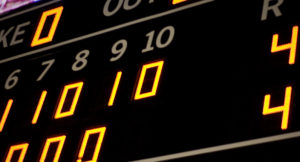Crooked numbers in baseball hold a unique significance in the world of sports. Generally, this term refers to any number greater than one. That number is recorded on the scoreboard when a team scores during an inning. The concept emerges from the idea that when a team puts more than one run on the board, the number displayed is considered “crooked”. As opposed to a zero or a single run that appears circular or straight on the scoreboard.
Understanding crooked numbers provides insight into a team’s offensive performance. It reflects an instance when they have successfully scored multiple runs in a single inning. This also adds an interesting element to the game. As fans and analysts often look out for moments when a team can shift the momentum by putting a crooked number on the board. In this context, crooked numbers in baseball stand as an emblem of a powerful offense, capable of making significant progress within a single inning.
Contents
Origins and Terminology
The term “crooked number” in baseball refers to a number greater than one that gets placed on the line score as a result of a point made during a half inning. Line scores display the runs, hits, and errors made by each team over the course of a game and are divided into nine columns for each inning with two rows, one for each team playing.
It is believed that the phrase originated in the early days of baseball when scoreboards and scorecards were much less sophisticated than they are today. During this time, scoreboards were made up of a series of tallies that were moved up or down to indicate the score. These tallies were known as “crooked numbers” because they were not perfectly aligned. Additionally, the term may be related to the fact that numbers that are not multiples of ten are often referred to as “crooked” in other contexts.
Crooked numbers are significant in the context of baseball games, as they often represent a big inning and can be a momentum-shifting event in a match. In contrast, posting only one run in an inning is referred to as a “straight” number – a less impactful achievement when compared to a crooked number.
As baseball evolved and statistics became more closely tracked and monitored, the term “crooked number” continued to be used to describe situations where a player hits a ball, resulting in a hit or a run but not counted as an at-bat because the player hadn’t actually reached the base. Nowadays, this terminology remains an important part of baseball’s rich history and vocabulary for fans, players, and commentators alike.
Crooked Numbers in a Game
In baseball, crooked numbers refer to innings in which the batting team scores at least two or more runs, resulting in a non-zero scoreboard figure that is not evenly divisible by one. The term “crooked” stems from the irregular shape of these integers on scoreboards and box scores, as opposed to the straight lines in zeroes or ones.
During a game, each team aims to produce crooked numbers at every opportunity, as this increases their chances of winning. Scoring crooked numbers typically occurs through a series of strong at-bats and effective base running. Solid hits, whether singles, doubles, or even home runs, can contribute to a team scoring multiple runs in a single inning.
For example, if a team scores three runs in the second inning, the line score for that inning would display a crooked number. The line score is divided into nine columns, representing the innings, and two rows, representing each team. This gives fans and commentators an overview of the game’s progress, including runs, hits, and errors by each team.
Enhancing base running strategies can also lead to putting crooked numbers on the scoreboard. This might involve stealing bases, taking advantage of defensive errors, and adeptly executing situational plays. Strong and skillful teamwork, combined with individual prowess, propels teams toward scoring more runs in a single inning.
In conclusion, crooked numbers play a crucial role in baseball games, as they demonstrate a team’s ability to capitalize on scoring opportunities. By strategically generating hits and executing smart base running, teams increase their chances of winning by producing crooked number innings.
Why Crooked Numbers Matter
Crooked numbers in baseball represent an important aspect of the game, as they can greatly impact a team’s chances of winning. Scoring multiple runs in a single inning often signifies a turning point in a game, as it shifts momentum in favor of the scoring team and puts pressure on the opposing team.
In many cases, a crooked number results from a successful rally by the batting team. This can involve stringing together multiple hits, drawing walks, or capitalizing on errors made by the opposing team. A strong rally not only adds runs to the score, but it can also wear down the opposing pitcher, ultimately leading to greater success in later innings.
Momentum shifts caused by crooked numbers can have psychological effects on both teams. When a team scores multiple runs in a single inning, confidence levels rise, and the players begin to perform better. On the other hand, the opposing team may start to feel pressure and become more prone to making mistakes. These psychological factors can contribute to a team’s overall success in a game.
Moreover, crooked numbers can affect the strategy employed by both teams. For instance, the team with the lead might choose to use more aggressive tactics on the basepaths, attempting to steal bases and force errors, whereas the trailing team might opt for a more conservative approach and focus on getting base runners.
In summary, crooked numbers are crucial in baseball, as they affect various aspects of the game like a team’s winning chances, momentum shifts, and strategic decisions made by the teams. These numbers illustrate the dynamic nature of baseball while highlighting the importance of capitalizing on opportunities to score multiple runs during a single inning.
Scoring Crooked Numbers
In baseball, scoring crooked numbers refers to when a team scores two or more runs in a single inning. This results in a non-zero score that is not evenly divisible by one, thus giving the appearance of a “crooked” number on scoreboards and box scores.
Achieving crooked numbers often depends on the performance of both the batter and the pitcher. An effective batter stays patient when facing different types of pitches, such as curveballs and sliders. Knowing when to take pitches and when to swing helps a batter reach base safely and increase scoring opportunities for their team.
Pitchers also contribute to the chances of scoring crooked numbers. Minimal mistakes, such as giving up walks or allowing stolen bases, can lead to fewer scoring chances for the opposing team. For instance, a pitcher who is unable to find the strike zone might end up walking the batter. Walks can lead to loaded bases and create scoring opportunities for the offense.
Various aspects of gameplay help a team achieve crooked numbers, including but not limited to:
- Stolen bases: If a runner on base can successfully steal a base, they increase their chances of scoring on a subsequent play or hit.
- Walks: A batter who is able to draw a walk puts themselves and the team in a better position to score runs.
- Home runs: When a batter hits a home run, they score as well as their teammates on base, which contributes to the crooked numbers on the scoreboard.
While pitching and batting play crucial roles in scoring crooked numbers, team strategies also come into play. Some teams focus on aggressive baserunning, while others prioritize capitalizing on opponents’ fielding mistakes.
In conclusion, scoring crooked numbers in baseball is a combination of batters, pitchers, and strategic plays working together to maximize scoring opportunities. A team that masters these elements will have a higher chance of putting up crooked numbers and, ultimately, winning games.
crooked number first 🫧✅ pic.twitter.com/bBRQzSwBtI
— Texas A&M Baseball (@AggieBaseball) May 9, 2023
Crooked vs Straight Innings
In baseball, innings can be classified as either crooked or straight, depending on the number of runs scored by a team in a single inning. Knowing the difference between these two types of innings is useful in understanding the game and interpreting its outcome.
A crooked inning occurs when a team scores two or more runs in a single inning. These types of innings often include successful consecutive half-innings, where the team scores one or more runs after playing two or more consecutive half innings without giving up a run. The term “crooked number” is used because the resulting run total for the inning appears irregular on scoreboards and line scores, with a digit other than zero and not evenly divisible by one.
On the other hand, a straight inning is when a team scores only a single run or no runs at all in an inning. This type of inning is sometimes referred to as a “picket fence” inning, as the scoring pattern in a line score resembles the slats of a picket fence.
Some key differences between crooked and straight innings include:
- Run Scoring: Crooked innings result in two or more runs being scored, whereas straight innings involve one or no runs.
- Impact on Games: Crooked innings can potentially change the outcome of a game, as multiple runs are scored in a short span, putting pressure on the opposing team. Straight innings generally have a lesser impact on the overall game.
- Strategies: Teams might adopt different strategies based on whether they are aiming for crooked or straight innings. For example, in a crooked inning, aggressive base-running and taking risks may be encouraged, while in a straight inning, a more conservative approach might be preferred.
In summary, understanding the concepts of crooked and straight innings can help spectators appreciate the nuances of baseball and follow the ongoing game. These differing types of innings influence a team’s strategies, as well as the dynamics and outcomes of baseball games.
Conclusion
Crooked numbers in baseball refer to an inning where a team scores two or more runs, contributing to an asymmetrical score line. This term is widely used to describe successful consecutive half-innings for a team, emphasizing their strategic approach to achieving success.
Incorporating crooked numbers into a team’s strategy can play a crucial role in gaining an advantage over the opposition. Strong offensive tactics and consistent execution in the field are essential factors for any team aiming to achieve these crooked numbers frequently throughout the game.
Understanding the concept of crooked numbers not only offers insight into the sport’s history, but it also demonstrates the significance of teamwork and communication. By working together and capitalizing on opportunities, teams can outscore their opponents and secure victories more effectively.
In conclusion, the term “crooked numbers” in baseball highlights the value of a well-coordinated game plan and a team’s ability to score multiple runs in a single inning. Mastering this aspect of baseball strategy can enhance a team’s overall success and contribute to a better performance on the field.


